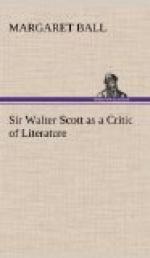This book and the prefaces to his own novels are likely to be thought of first when Scott is spoken of as a critic. The connection between the Minstrelsy and the novels has often been pointed out, ever since the day of the contemporary who, on reading the ballads with their introductions, exclaimed that in that book were the elements of a hundred historical romances.[34] The interest of the earlier work is undoubtedly multiplied by the associations in the light of which we read it—associations connected with the editor’s whole experience as an author, from the Lay of the Last Minstrel to Castle Dangerous.
Important as the Minstrelsy is from the point of view of literary criticism, the material of its introductions is chiefly historical. The introduction in the original edition gives an account of life on the Border in the fifteenth and sixteenth centuries, with the outlines of many of the events that stimulated ballad-making, and an analysis of the temper of the Marchmen among whom this kind of poetry flourished; then by special introductions and notes to the poems an attempt is made to explain both the incidents on which they seem to have been founded, and parallel cases that appear in tradition or record. Some enthusiastic comment is included, of the kind that was so natural to Scott, on the effect of ballad poetry upon a spirited and warlike people. The writer continues: “But it is not the Editor’s present intention to enter upon a history of Border poetry; a subject of great difficulty, and which the extent of his information does not as yet permit him to engage in.” It was, in fact, nearly thirty years later[35] that Scott wrote the Remarks on Popular Poetry which since that date have formed an introduction to the book, as well as the essay, On Imitations of the Ancient Ballad, which at present precedes the third part. The more purely literary side of the editor’s duty—leaving out of account the modern poems written by Scott and others—was exhibited chiefly in the construction of texts, a matter of which I shall speak later, after considering his views of the origin and character of folk-poetry in general.
But first we may recall the fact that Scott was following a fairly well established vogue in giving scholarly attention to ancient popular poetry. A revival of interest in the study of mediaeval literature had been stimulated in England by the publication of Percy’s Reliques in 1765 and Warton’s History of English Poetry in 1774. In 1800 there were enough well-known antiquaries to keep Scott from being in any sense lonely. Among them Joseph Ritson[36] was the most learned, but he was crotchety in the extreme; and while his notions as to research were in advance of his time, his controversial style resembled that of the seventeenth century. George Ellis,[37] on the other hand, was distinguished by an eighteenth-century urbanity, and his combination




